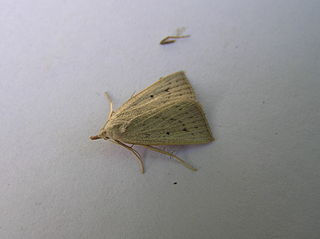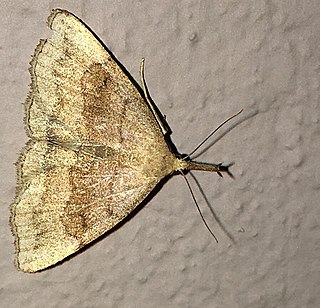
The Noctuidae, commonly known as owlet moths, cutworms or armyworms, are the most controversial family in the superfamily Noctuoidea because many of the clades are constantly changing, along with the other families of the Noctuoidea. It was considered the largest family in Lepidoptera for a long time, but after regrouping Lymantriinae, Catocalinae and Calpinae within the family Erebidae, the latter holds this title now. Currently, Noctuidae is the second largest family in Noctuoidea, with about 1,089 genera and 11,772 species. However, this classification is still contingent, as more changes continue to appear between Noctuidae and Erebidae.

Chytolita is a monotypic litter moth genus of the family Erebidae erected by Augustus Radcliffe Grote in 1873. Its only species, Chytolita morbidalis, the morbid owlet moth or morbid owlet, was first described by Achille Guenée in 1854. It is found in large parts of North America, from coast to coast in the north and south to North Carolina, Texas and Florida in the west. The habitat consists of deciduous woods and edges.

Macrochilo is a genus of litter moths of the family Erebidae. The genus was erected by Jacob Hübner in 1825.

Phalaenophana is a genus of litter moths of the family Erebidae. The species was first described by Augustus Radcliffe Grote in 1873.

Phalaenostola is a genus of litter moths of the family Erebidae. The genus was erected by Augustus Radcliffe Grote in 1873.

Xestia badicollis, the northern variable dart, northern conifer dart or white pine cutworm when referring to the larval stage, is a moth of the family Noctuidae. The species was first described by Augustus Radcliffe Grote in 1873. It is found in North America from Nova Scotia to North Carolina, west to Missouri and Ontario.

Catocala junctura, the joined underwing or Stretch's underwing, is an moth in the family Erebidae. The species was first described by Francis Walker in 1858. It is found throughout temperate North America ranging from New York and Pennsylvania west to Montana, Colorado, Oklahoma, Arizona and into Texas, and north to southern Illinois, extreme southern Alberta and Saskatchewan; it has also been recorded west of the Rocky Mountains from California and south-eastern British Columbia. It is typically found near water, where the food plants of its caterpillar larvae grow plentifully.

Redectis vitrea, the scalloped snout or white-spotted redectis, is a litter moth of the family Erebidae. The species was first described by Augustus Radcliffe Grote in 1878. It is found in the United States from Illinois to south-eastern Massachusetts, south to Texas and Florida.
Idia scobialis, the smoky idia, is a litter moth of the family Erebidae. The species was first described by Augustus Radcliffe Grote in 1880. It is found in North America from Michigan, southern Quebec and Maine, south to Florida and at least Kentucky.

Phalaenophana pyramusalis, the dark-banded owlet, is a moth of the family Erebidae. The species was first described by Francis Walker in 1859. It is found in North America from Saskatchewan to Nova Scotia, south to North Carolina and Texas.

Macrochilo litophora, the angulate fan-foot or brown-lined owlet moth, is a litter moth of the family Erebidae. The species was first described by Augustus Radcliffe Grote in 1873. It is found in the United States from Wisconsin, east to Massachusetts, south to North Carolina, South Carolina, Mississippi and Texas.
Macrochilo bivittata, the two-striped snout-moth, is a litter moth of the family Erebidae. The species was first described by Augustus Radcliffe Grote in 1877. It is found from the Atlantic coast west across the parklands and southern boreal forest of North America to central Alberta, south to Massachusetts and Ohio.

Phalaenostola eumelusalis, the punctuated owlet or dark phalaenostola, is a moth of the family Erebidae. The species was first described by Francis Walker in 1859. It is found in North America from New Brunswick, North Dakota and South Dakota to Maine, south to Georgia and Iowa. In the north it is also found in Saskatchewan.
Phalaenostola hanhami, also called Hanham's owlet or Hanham's snout moth, is a litter moth of the family Erebidae. The species was first described by J. B. Smith in 1899. It is found in North America from Nova Scotia, west across Canada to central Alberta, south to Massachusetts and New York.

Phalaenostola metonalis, the pale phalaenostola, tufted snout or pale epidelta, is a moth of the family Erebidae. The species was first described by Francis Walker in 1859. It is found in North America from British Columbia to Newfoundland, south to North Carolina, west to Missouri.

Isogona tenuis, the thin-lined owlet, is a moth of the family Erebidae. The species was first described by Augustus Radcliffe Grote in 1872. It is found from Ontario, Wisconsin, Ohio and New Jersey, south to Florida and Texas.

Colobochyla interpuncta, the swamp belle or yellow-lined owlet, is a moth of the family Erebidae. The species was first described by Augustus Radcliffe Grote in 1872. It is found in North American wetlands from Wisconsin to Nova Scotia south to Florida and Texas.
Spargaloma is a monotypic moth genus in the family Erebidae. Its only species is Spargaloma sexpunctata, the six-spotted gray. Both the genus and species were first described by Augustus Radcliffe Grote in 1873. It is found from coast to coast in lower Canada south in the east to Florida, Mississippi and Arkansas, in the west to California.
Stiriina is a subtribe of owlet moths in the family Noctuidae. There are at least 50 described species in Stiriina.
Stiriini is a tribe of owlet moths in the family Noctuidae. There are at least 120 described species in Stiriini.













